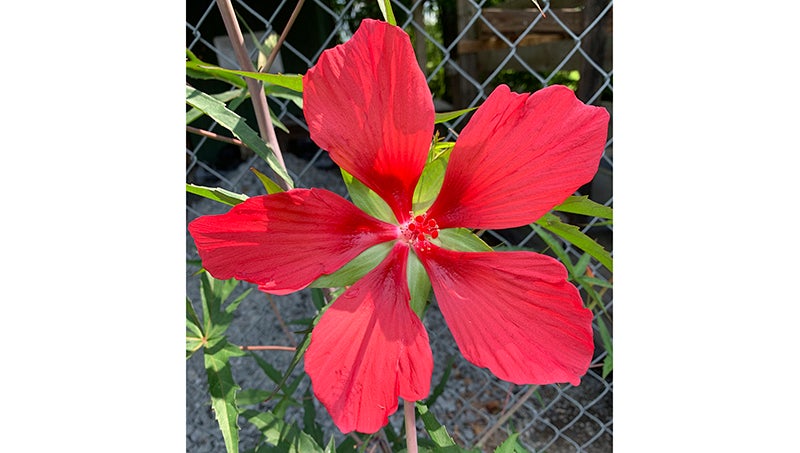Are you tired of the rain yet?
Published 10:18 am Monday, July 6, 2020

- TEXAS STAR: It’s a native of North America, but not of Texas. This vigorous perennial produces large, star-shaped, white or bright red flowers that bloom from late spring into fall. It’s a plant that doesn’t mind having its “feet wet” for a few days at a time, which makes it ideal for growing in low-lying areas, or rain gardens. This Texas star hibiscus is located in the Teaching Garden at the Beaufort County Extension Center. (Ashley Latham)
|
Getting your Trinity Audio player ready...
|
This past weekend was the first time I have been able to mow my yard in nearly three weeks. Pulling the climate data from Warren Field, in Washington, does not reflect what happened at my house at all! In fact, in keeping records at my house, I found that I had received 3.99 inches in the month of June as compared to 1.33 inches at Warren Field. The station at the Pamlico Aquaculture Field Lab recorded 7.05 inches and the Tidewater Research Station recorded 2.75 inches in the month of June. However, it seemed like it rained a little every day for nearly two weeks at my house. There were places in my yard that just would not dry up enough for me to mow.
In eastern North Carolina, we receive somewhere in the neighborhood of 50 inches of rainfall each year; some areas a little more and some a little less. Our plants need one inch of water each week to thrive. In the world of averages, we come close to this every year, but that doesn’t mean we receive our rain in 1-inch weekly increments. For instance, in looking at the records for my house in the month of June, it rained 14 out of the 30 days. Most of the rains were not large-scale precipitation events, but there was enough to keep it wet for nearly the entire month! Although we do not have a whole wide range of topography, we still have water that stands in certain areas of our lawns. What can you do?
There is the obvious: improve drainage in our yards to help them dry out quicker. This can be achieved by cleaning ditches, constructing drainage ways and installing drainage tiles for your home’s downspouts. While doing this will help move the water from your property a little quicker, it will not help downstream from you. In fact, this contributes to flooding downstream: all that water has to go somewhere! I feel like we fight Mother Nature all of the time and for needless reasons.
There are alternative, more long-term and sustainable solutions that can be more beneficial to our surroundings and our neighbors. One way to begin dealing with all of this water is to remove some of the impervious surfaces from our property. For instance, look at a gravel driveway, permeable pavement or pavers as alternatives to asphalt and concrete. Gravel allows rainwater to seep through. Permeable pavement does the same thing but with a bit more structure. Permeable pavement can be more expensive and typically requires design by a certified professional. This is not an alternative for all applications but can certainly replace your impermeable driveway or walkways in a residential setting. Pavers, installed with gravel in between, can accomplish much of the same stormwater and water-quality benefits as permeable pavement.
What about your house: you can’t make that a permeable surface, can you? I am not aware of a way to do that just yet, although water features do create a zen-like ambiance, I’m not ready to have a dripping roof! What we can do is redirect our downspouts to rain gardens. At my house, I have an area of the front yard that just doesn’t drain very quickly. However, it will drain naturally once we go without rain for a day or two. This is a great scenario to look at installing a rain garden.
Rain gardens are areas of your property where you can allow water to sit for one to three days while it naturally filters back into the soil. Our soil acts as a natural filter to strip the water of harmful pollutants and keep them from reaching our streams, rivers and estuaries. Growing plants that can handle wet feet in these areas enhance the soil’s filtering potential too! Rain gardens require a little thought up front, a little excavation work and a little maintenance to get started, but the results can make your property more functional and aesthetically pleasing, adding value. Rain gardens are an amazing way to add some pollinator habitat to your landscape, as well. Many of the plants that will do well in a rain garden are pollinator friendly such as hibiscus and swamp milkweed. Living in one of the counties with the most shoreline in the entire state of North Carolina, this just makes sense!
If you would like to start a rain garden, visit our extension website at beaufort.ces.ncsu.edu or call the Extension Center near you for more information. N.C. State Extension has a 12-page guide to get you started, which is available at your local center. We also have our Extension Gardener Plant Toolbox that can aid in selecting the right plants plants.ces.ncsu.edu. The Master Gardener Hotline is open in the Beaufort County Center from 10 a.m. until noon Mondays and Wednesdays. If you have other questions or concerns involving horticulture, email gene_fox@ncsu.edu or call 252-946-0111.
Gene Fox is the area consumer horticulture agent with N.C. Cooperative Extension.





